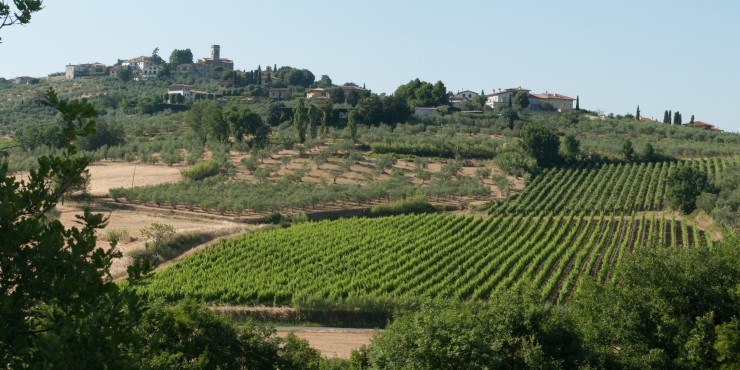Tizzana
Azienda Agricola “La Greggia” is located in Tizzana, part of the Municipality of Quarrata (Pistoia).
The first traces of this “Castle” date back to 1251 although before that the country was already defended by castle walls and a deck, under the jurisdiction of Pistoia.
From 1251 until 1253 the Florentines besieged the castle of Tizzana. The hard resistance of “Castellans” forced the Florentines to negotiate a peace, signed on 24 June 1253.
Tizzana, in 1306, with many small castles of its district was ceded, with a public act, to the Florentine Republic.
In 1325 the leader Castruccio Castracani attacked the three Florentine strongholds which then existed in the area (Artimino, Carmignano and Tizzana). Only Tizzana managed to withstand the siege.
At the end of the fourteenth century, the village continued to be considered the prominent strategic objective also in the struggle of the Florentines against the Milanese Gian Galeazzo Visconti.
In the second half of the fifteenth century, Tizzana was closely linked to the disputes between the families of Panciatichi (who had chosen the village as their headquarters) and Cancellieri.
The plague of 1523 struck hard the Castle of Tizzana.
Later, during the Medici and Lorraine period, the Castle fell into decline due to its diminished strategic and military importance and its fortifications gradually fell into ruin.
In 1772 it was the seat of an authority subjected to the royal vicar of Pistoia. At present there are only faint traces of the fortress walls around the top of the hill.
The history of a farm
from family Niccolini to family de ‘Ricci.
The documents relating to the origin of the family Niccolini date from the early decades of the Middle Ages. Among their most famous figures we remind:
Lapo di Giovanni di Lapo (1356-1429), who was a wealthy merchant and an important political figure in the Republican Florence, who consolidated the Florentine fortunes of his family.
Agnolo di Matteo di Agnolo (1505-1567) trustworthy man of Cosimo I de ‘Medici, in 1530 he married Alessandra of Vincenzo Ugolini by whom he had four children: Matteo, Lorenzo, Giovanni and Maria who married Roberto di Filippo de’ Ricci. Agnolo, widowed, in 1550 was honored for his long career at the service of Cosimo with the designation to the Cardinalate with the assignment of the Diocese of Pisa.
Giovanni di Agnolo di Matteo (1544-1611) consolidated the political and economic fortune of his family.
As loyalty Ferdinando II de ‘Medici granted the title of Marquis of Ponsacco and Camugliano (1637) to Filippo, son of Giovanni Niccolini (1586-1666).
Since then the family distinguished itself for the positions held and the advantageous marriages, becoming one of the most powerful families of the Grand Duchy of Tuscany.
Anna Niccolini, Lapo’s daughter was given her hand in marriage to the knight Giovan Batta de’ Ricci and among the goods brought him a hill in Tizzana « … a property of thirty hectares of reclaimed lands and planted with vines, olive trees and orchards with inside six houses for workers.»
The famous clergyman and reformer Scipione de’ Ricci born into a noble and pious family of Florence, of which the Dominican Santa Caterina de’ Ricci (1522-1590), called “The Holy of Prato”
«…. My father was the senator president Pier Francesco de ‘Ricci, Florentine, who had married in first nuptials Alessandra Antinori, daughter of the president of that last name, then after her death he passed to the second nuptials with Luisa, daughter of Baron Bettino Ricasoli, captain of the Swiss Guard of Grand Duke of Tuscany. From her he had five sons, the last of which after a few days of life is flown to heaven. I was the third-born, who was born on 19 January 1741 and regenerated by divine grace in the holy baptism I was given the name Scipione… » [Agenore Gelli – “Memorie del Vescovo Scipione de’ Ricci Vescovo di Prato e Pistoia scritte da lui medesimo” ed. Felice Le Monnier – Firenze 1865]
This one, become Bishop of Prato and Pistoia (1780-1791), «sent to his Bishopric wine, oil and fruit of his property on the hills of Tizzana … » [E. Repetti – Dizionario Geografico Fisico Storico della Toscana- 1839- Vol.V]
In 1795 the Bishop sold his property of Tizzana to another owner that held it for 150 years. Around 1950 the property was sold to more people and among these to Simons-Moretti, who now hold 60% of the property.
Thanks to the tireless passion of Alfredo Moretti for the land, history and art is born the Azienda Agricola “La Greggia”.
Alfredo Moretti has chosen these lands, fascinated by the history of two families who had owned and cultivated them and by the beauty of vines that cover the Farm of twenty hectares.
Today the memory of Bishop Scipione de ‘Ricci lives on the labels of our wines.
 Deutsch
Deutsch  Italiano
Italiano 